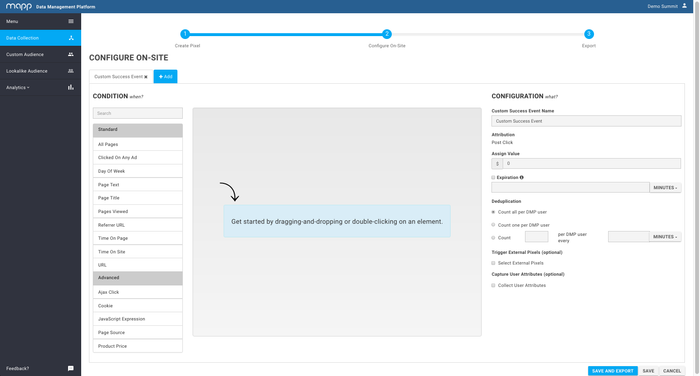This entry provides detailed information on how to configure the Mapp Pixel.
| Contents on This Page |
|---|
Apart from the default Pixel settings and the possibility to enable or disable specific On-Site pixel modules you can also configure Custom Events that are only relevant for the given client. There are a variety of places on a website where you may want to measure specific user interactions that won't be tracked by default. The DMP allows you to capture click, gesture or behavior by visitors to your website by means of Custom Events and Custom Success Events that are configurable through the platform's web interface. With the Populate Custom Data feature you can even collect the value of a specific element and store it as a custom attribute. It helps you to understand how users are interacting with your website and they can serve as input to define advanced Custom or Lookalike Audiences.
When you start configuring the pixel you will be prompted to add a Custom Success Event or Custom Event. The workflow of creating a Custom Success Event and Custom Event are described below.
After you create a pixel you can choose to configure your pixel. Configuration of the pixel will happen within a Tag Management interface.
The left part (Condition) represents the rules the Custom Success Event must apply to. By dragging and dropping or double-clicking on the elements you are able to create the rule. For an in-depth explanation of each of the data elements, including logic and filtering options, please see the data overview.
By dragging and dropping or double-clicking on the elements you are able to create the rule. For an in-depth explanation of each of the data elements, including logic and filtering options, please see the data overview.
The right side (Configuration) enables you to further configure your rule. Add a Custom Success Event Name.
Add Attribution.
Assign the value of the Custom Success Event. Please note that this is only possible in US Dollars.
Select the expiration of the Custom Success Event in minutes, hours or days.
Select one of the options under Deduplication. This will set the amount of Custom Success Events to be counted per user.
The left part (Condition) represents the rules the Custom Success Event must apply to. By dragging and dropping or double-clicking on the elements you are able to create the rule. For an in-depth explanation of each of the data elements, including logic and filtering options, please see the data overview.
The right side (Configuration) enables you to further configure your rule. Add a Custom Event Name.
OPTIONAL: Populate External Pixel. You are able to populate an external Custom Event. Check the box, select a platform and filter by All (network-wide and advertiser-specific Custom Events), Network (only network-wide Custom Events) or select a specific advertiser. Select one or multiple Custom Events or create a new one.

The chart below provides a complete overview of the data available in the Configure step of Data Collection.
Please contact your Client Services Manager to enable the Advanced options for your organisation. Please note that only users with technical knowledge about CSS and JavaScript will be granted permission. |
| Category | Subcategory | Logic | Options | Explanation |
|---|---|---|---|---|
| Standard | All Pages | No further options | No further options | This will include all pages of the website the pixel has been placed on. |
| Clicked On Any Ad | No further options | No further options | Includes users who have clicked on any ad on the website the pixel has been placed on. | |
| Day Of Week | Between Is | Monday - Sunday | The weekday when the event took place. | |
| Page Text | Contains Doesn't Contain | Enter the page text | The pages containing a string of text where the event took place, except text within an iFrame. | |
| Page Title | Equals Contains Doesn't Equal Doesn't Contain | Enter the page title | The pages containing the title where the event took place. | |
| Pages Viewed Within Visit | Between At Least At Most | Enter the number of viewed pages | The amount of pages a user has visited. | |
| Referrer URL | Equals Contains Doesn't Contain Doesn't Equal | Enter one or multiple URLs | The URL a user came from when the event took place. | |
Time Spent - On Page or Within Visit | At Most At Least | Enter the number of seconds | The duration a user has been on a page or on the website. | |
| URL | Equals Contains Doesn't Contain Doesn't Equal | Enter one or multiple URLs | The URL a user visited when the event took place. | |
| Advanced | Ajax Click | No Further Options | Insert CSS path | Users who clicked within a page on a specific element, without leaving the page. |
| Cookie | Contains Doesn't Contain | Enter cookie text | Users who match a specific string of text in their cookie. | |
| JavaScript Expression | No Further Options | Insert JavaScript Expression | Conditionally fires Custom (Success) Event based on outcome Javascript Expressions. | |
| Page Source | Contains Doesn't Contain | Enter the text from the page source | The pages containing a string of text from the page source where the event took place. | |
| Product Price - Insert CSS path to locate price | At Least At Most | Insert product price | The pages containing a minimum or maximum product price. |